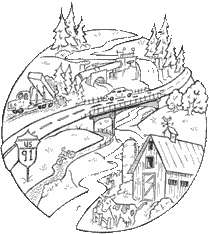 |

(The science and history of the Boltonville section of the Wells River watershed)
|
|
|
FARMS
& RIVERS |
BLUE
Home
Project Description
Schedule
Stations
& Data
Photo
Gallery
Farms
& Rivers
CVTA
Home Page
|
Article
by Alice Allen, co-owner of A-lens Farm, Newbury, VT
|
| FARMING
BESIDE A RIVER BRINGS
WITH IT A CERTAIN RESPONSIBILITY. It is the river that
gives the farm its wealth! To protect and share that wealth becomes a life-long
learning process. On this farm, as with many other river valley farms, some
of the buildings were built in flood plain. A few folks from the generation
who farmed here and weathered the flood of '27 are still with us today,
and they have told us about it. If a flood of that magnitude occurred today,
would this barn stand? Would the heifer barn be washed away? No one knows
for sure. |
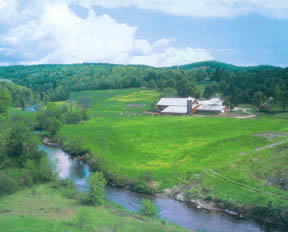 |
|
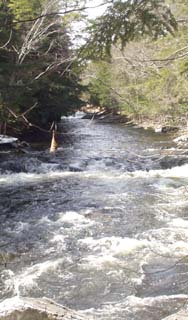
|
WHAT
WE DO KNOW IS THAT IT IS WORTH PAYING ATTENTION TO THE LESSONS THAT THE
RIVER TEACHES US EVERY DAY. The soils along the meadow on this
farm are predominantly Merrimack, Hadley, Hartland and Winooski with varying
degrees of slope as you leave the flood plain. They are moderately to well-drained
which is rather important when the river does leave its banks. Within the
last decade or so, the Wells River has become much more dynamic than most
folks can remember from previous decades. 1989 was the first time, in the
recollection of local "oldtimers" that the Wells had flooded in
late July or August. This meadow went under water on the last Sunday of
July, 1989. We have learned since then to use very portable fences! With
a few hours of heavy rain, the Wells can rise from a mere trickle (where
you can walk across barefooted and not get your feet wet) to flood stage.
It's a good thing we don't have a corn crop on the meadow, or we would be
in serious trouble. |
| WE
PAY ATTENTION TO THE RIVER AND THE WILDLIFE
who make their home here and move our fences to higher ground at
the first sign of rising water. When we see the woodchucks leaving their
burrows we move our fences! As the river rises quickly, it also goes down
quickly too. The flood is apt to leave debris in the grass: sand, sticks,
leaves and mud. It is amazing though, how a gentle rain can easily wash
the debris from the growing grass. The buffer zone of trees and bushes along
the river's edge helps to collect much of the debris traveling along with
the flood waters. If we had been growing corn on the meadow, the damage
and resulting loss of feed could have been severe. |
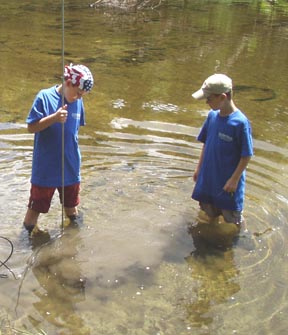 |
 |
IN
THE WEE HOURS OF AN EARLY FALL MORNING, UNDER A GLORIOUSLY FULL MOON,
there is hardly a more beautiful sight than watching a herd of cows peacefully
grazing in the bright moonlight above the sparkling river as small wisps
of fog begin to form and rise off the meadow. We dairy farmers are very
lucky to live and work this close to Nature. We are trying to become better
stewards of the river and surrounding land. We have learned to keep the
cows from wandering into the river, eroding the banks and depositing their
manure in the water. We have worked to restore the riparian buffers. And,
we have decided not to "till" the floodplain soil but to pasture
it instead. |
| AS
LONG AS WE CONTINUOUSLY SEEK ANSWERS TO THE QUESTIONS OF THOUGHTFUL STEWARDSHIP,
as long as we keep mindful of our responsibility to protect and respect
the river, as long as we share what the river teaches us with all those
who are willing to listen, then we maybe can retain the privilege of farming
in these fertile river valleys. |
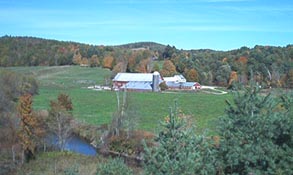 |
|
|
|
BLUE
is funded by a Vermont Watershed Grant and supported by
the White River Natural Resources Conservation District
|







